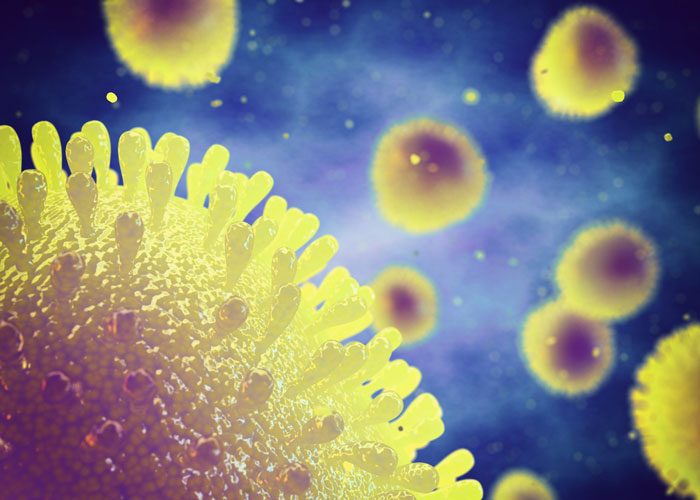Influenza viruses can help mutated viral proteins fold and function
Posted: 27 September 2017 | Dr Zara Kassam (Drug Target Review) | No comments yet
A new study from has shed light on just how viruses evolve so quickly and offers a potential way to slow them down…


A new study from has shed light on just how viruses evolve so quickly and offers a potential way to slow them down.
The researchers at Massachusetts Institute of Technology (MIT) found that flu viruses’ rapid evolution relies in part on their ability to hijack some of the cellular machinery of the infected host cell — specifically, a group of proteins called chaperones, which help other proteins fold into the correct shape. When the viruses were unable to get help from these chaperones, they did not evolve as rapidly as when they could obtain extensive help from host chaperones.
When the viruses were unable to get help from these chaperones, they did not evolve as rapidly as when they could obtain extensive help from host chaperones.
Moreover, the specific evolutionary trajectories followed by individual flu proteins depend on host chaperone activities.
The findings suggest that interfering with host cell chaperones could help prevent flu viruses from becoming resistant to existing drugs and vaccines, said Matthew Shoulders, the Whitehead Career Development Associate Professor of Chemistry at MIT.
“It’s relatively easy to make a drug that kills a virus, or an antibody that stops a virus from propagating, but it’s very hard to make one that the virus doesn’t promptly escape from once you start using it,” said Dr Shoulders.
“Our data suggest that, at some point in the future, targeting host chaperones might restrict the ability of a virus to evolve and allow us to kill viruses before they become drug resistant,” said Dr Shoulders.
Flu viruses carry eight genome segments, all encoded by RNA. Of particular interest to flu researchers is the gene for the hemagglutinin protein, which is displayed on the surface of the viral envelope and interacts with cells of the infected host. Most flu vaccines target this protein, but these vaccines have to be updated every year to keep up with the protein’s ability to evolve quickly.
Most flu vaccines target this protein, but these vaccines have to be updated every year to keep up with the protein’s ability to evolve quickly.
However, this rapid evolution also poses a challenge for the viruses themselves. When proteins mutate, they may become unable to fold into the shape they need to assume to perform their function. Previous research, such as the pioneering work of the late Susan Lindquist, a biology professor at MIT, has shown that in many organisms,
Previous research, such as the pioneering work of the late Susan Lindquist, a biology professor at MIT, has shown that in many organisms, the evolution of endogenous proteins depends on the ability of that organism’s chaperones to help mutated proteins fold.
In this study, the MIT team investigated whether viruses can take advantage of their host’s chaperone proteins to help with their own evolution.
“Viral proteins are known to interact with host chaperones, so we suspected that this interplay could have a major impact on what evolutionary pathways are available to the virus,” said Dr Shoulders.
To test their hypothesis, the researchers generated one set of cells with low protein-folding activity by inhibiting a key chaperone protein called heat shock protein 90 (Hsp90). In another set of cells, they used chemical genetic methods previously developed by Shoulders to enhance the levels of numerous chaperone proteins, creating a cellular environment with high protein-folding activity.
The researchers infected both sets of cells, plus a group of cells with normal chaperone levels, with a strain of flu and then allowed the virus to evolve for nearly 200 generations. They found that the virus did indeed evolve faster in the cells with higher chaperone levels than in the cells with inhibited chaperone proteins.
“This finding suggests that influenza will acquire new traits that might be beneficial for it faster when you have the heat shock response activated, and slower when you have key chaperones inhibited,” said Dr Shoulders.
The researchers also identified specific proteins that tend to become more mutated in cells with more chaperones. One of these is the hemagglutinin protein, and another is an enzyme called PA, which is a type of RNA polymerase that helps the virus copy its genes. The team also identified specific amino acids within these proteins that are more likely to become mutated in different protein-folding environments.
Targeting this phenomenon could offer a way to delay viral evolution and decelerate escape from existing drugs and vaccines, the researchers say. Many chaperone inhibitors already exist, and some are now being tested in clinical trials to treat cancer and some viral infections. The new data imply that treating patients with a chaperone-inhibiting drug along with another antiviral therapy, such as a drug or vaccine, could help ensure that the virus does not evolve resistance to the therapeutic.
The researchers believe this phenomenon is likely also found in other viruses, and they are now studying HIV, another virus that mutates rapidly. They also plan to study how a host cell’s protein-folding capacity may affect the evolution of antiviral drug or antibody resistance, using therapeutics that circulating viruses are already resistant to.
“We can recapitulate environmental pressures like antiviral drugs in the lab, in the context of different host protein-folding environments, and see whether there’s a big impact. Our data suggest that there’s going to be, but we have to actually test it out,” said Dr Shoulders.
Related topics
Proteomics, Research & Development, RNAs
Related conditions
Influenza
Related organisations
Massachusetts Institute of Technology
Related people
Matthew Shoulders, Susan Lindquist



